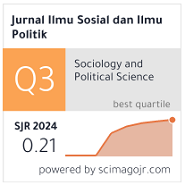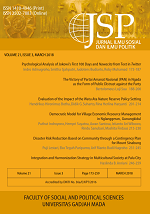The Campaign of Papua Peace Network for Papua Peace Land
Cahyo Pamungkas(1*)
(1) Indonesian Institute of Sciences (LIPI).
(*) Corresponding Author
Abstract
This article aims to narrate a series of peaceful campaigns conducted by Papua Peace Network (PPN) for Papua Peace Land. This informal network consists of several groups of civil societies, such as religious organizations, ethnic groups, NGOs, and academicians. The PPN has some objectives that are to connect conflicted groups in Papua land, and to help both Papuan people and Indonesian government preparing an inclusive dialogue. This article results from research between 2013 and 2017. The data collection used observation of peaceful campaign of PPN, interviews, and archival research. This research shows that although a series of peaceful campaigns have been conducted by PPN both at the national and local levels between 2013 and 2016, but political violence still increases in Papua land. On another side, the national government only focuses on social and economic development issues, in particular, infrastructure projects, instead of political issues. Government officials involved in peaceful campaigns conducted by PPN had no power enough to implement some peace recommendations due to the national government has no a roadmap to resolve the conflict between Jakarta and Papua peacefully. The article argues that a continuously informal communication between conflicted parties is a necessary condition, but it is not a sufficient condition to create a positive peace. Therefore, the National Government is strongly suggested to implement an inclusive national dialogue with Papuan people.
Keywords
Full Text:
PDFReferences
Anderson, B. (2015). Papua’s insecurity: State failure in the Indonesian periphery. Honolulu, Hawaii: East-West Center.
Bhakti, I. N., Yanuarti, S., & Nurhasim, M. (January, 2009). Military politics, ethnicity, and conflict in Indonesia. (January, pp. 1-34, CRISE Working Paper No. 62).
Braithwaite, J., Braithwaite, V., Cookson, M., & Dunn, L. (2010). Anomie and violence: non-truth and reconciliation in Indonesian peacebuilding. Canberra: Australian National University.
Chauvel, R. (n.d.). Constructing Papuan nationalism: history, ethnicity, and adaptation. Retrieved from https://www.eastwestcenter. org/fileadmin/stored/pdfs/PS014.pdf
Drooglever, P. (2010). An act of free choice: decolonization, and the right to self determination, London: One World Publication.
Elisabeth, A., Tebay, N., Sumule, A., Sudrajad, Pamungkas, C., Siregar, L.A. & Manufandu, S. (2015). Bersama-sama Membangun Papua Damai. Policy Brief. Jakarta: LIPI & JDP. Retrieved from http://jdp- dialog.org/download/doc_download/63-policy-brief- tim-kajian-papua-lipi-jdp
Elisabeth, A., Widjojo, M. S., Kurniawan, R., C., & Blegur, S. (2004). Pemetaan peran dan kepentingan para aktor dalam konflik Papua. Jakarta: LIPI Press.
Elisabeth, A., Widjojo, M.S., Pamungkas, C., Al Rahab, A.E., (2005). Agenda dan potensi damai di Papua. Jakarta: LIPI Press.
ELSAM. (2015). Ancaman berkelanjutan, penyelesaian stagnan, laporan situasi hak asasi manusia di Indonesia 2013. Jakarta: ELSAM.
Galtung, J. (1969). Violence, peace, and peace research. Journal of Peace Research, 6(3), 167-191.
Heidbuchel, E. (2007). The West Papua conflict in Indonesia: Actor, issues, and approaches. Wettenberg: Johannes Hermann J & J Verlag.
Hernawan, Y. B., & Braithwaite, J. From the theatre of torture to the theatre of peace: The politics of torture and re- imagining peacebuilding in Papua, Indonesia (Unpublished doctoral dissertation). Australian National University.
ICG. (2012). Indonesia: dinamika kekerasan di Papua. Brussels: International Crisis Group.
International Crisis Group (ICG). (2010). Radikalisasi dan dialog di Papua. Brussels: International Crisis Group.
International Coalition of Papua (ICP). (2017). Human rights in West Papua 2017. Wuppertal, Germany: ICP.
King, P., Elmslie, J., & Webb-Gannon, C. (2011). Comprehending West Papua. Sydney: Centre for Peace and Conflict Studies, University of Sydney.
Kirksey, E. (2012). Freedom in entangled worlds: West Papua and the architecture of global power. Durham and London: Duke University Press.
Kivimaki, T . & Thorning, R. (2002). Democrat izat ion and reg ional power sharing in Papua/Irian Jaya: increased opportunities and decreased motivations for violence. Asian Survey, 42(4), 651-672.
Lundry, C. (2009). Separatism and state cohesion in Eastern Indonesia. (Unpublished doctoral dissertation). Arizona State University.
MacLeod, J. (2011). Pathways to dialogue in Papua: diplomacy, armed struggle or nonviolent resistance?. In Bartkowski, M. (Ed.). Rediscovering Nonviolent History: Civil Resistance Beneath Eulogized Violence. Colorado: Boulder, CO, Lynne Rienner Publihsers.
Martanto, U. (2007). Perubahan lingkungan dan konflik kekerasan membaca Papua melalui pendekatan environmental security. Jurnal Ilmu Sosial dan Ilmu Politik, 11(2), 173-192.
McGibbon, R. (n.d.). Pitfalls of Papua: Understanding the conflict and its place in Australia–Indonesia relations. Retrieved from https://www.lowyinstitute.org/sites/ default/files/pubfiles/McGibbon,_Pitfalls_ of_Papua_1.pdf
Pamungkas, C. (2017). Internasionalisasi Konflik Papua: Menyelusuri Perjalanan ULMWP dan Diaspora Papua. In C. Pamungkas & S. R. Rusdiyarti (Eds.), Updating Papua Road Map (pp. 171). Jakarta, Indonesia: Yayasan Pustaka Obor Indonesia &Tim Kajian Papua – Lembaga Ilmu Pengetahuan Indonesia.
Penyelesaian Papua dengan Pendekatan Pembangunan. (2017). Suara Pembaruan, November 10. http://sp.beritasatu.com/pages/e-paper/2017/11/10/files/assets/basic- html/page-3.html#
Rutherford, D. (2012). Laughing at Leviathan: Sovereignty and audience in West Papua. Chicago, IL: University of Chicago Press.
Santoso, P. (2012). Ber-NKRI Secara Lebih Baik: Telaah Etis Percepatan Pembangunan Papua. Retriev ed from http://www. academia.edu/1098076/Ber-NKRI_Secara_ Leb ih_Baik _-_Prasyarat_Percepat an_ Pembangunan_Papua
Supriyono, J. (2014). Diskursus kolonialistik dalam pembangunan Papua. Jurnal Ultima Humaniora, 1, 59-78.
Suryawan, I. N. (2011).’Komin Tipu Komin: Elit Lokal dalam Dinamika Otonomi Khusus dan Pemekaran Daerah di Papua. Jurnal Ilmu Sosial dan Ilmu Politik, 15(2), 140-153.
Tebay, N. (2009). Dialog Jakarta-Papua: sebuah perspektif Papua. Jayapura: Sekretariat Keadilan & Perdamaian, Keuskupan Jayapura.
Tim Kajian Papua LIPI & Jaringan Damai Papua. (2015). [Notulensi Pertemuan Eksploratif Ketujuh di Bogor]. Unpublished raw data.
Viartasiwi, N. (2014). Autonomy and Decentralization as Rem ed ies ? : Counterinsurgency Tactics for the West Papua Conflict in Democratic Indonesia. 立命館国際 研究, 27(1), 283-304.
Wassel, T. (2014). Timor-Leste: Links between peacebuilding, conflict prevention and durable solutions to displacement. Washington D.C.: Brookings Institution.
Widjojo, M. S.& Tebay, N. (2010). Indikator Papua Tanah Damai versi Masyarakat Papua. Jayapura: Jaringan Damai Papua.
Wilson. (2017). Transformasi gerakan kaum muda Papua In C. Pamungkas & S. R. Rusdiyarti (Eds.), Updating Papua Road Map. Jakarta, Indonesia: Yayasan Pustaka Obor Indonesia & Tim Kajian Papua – Lembaga Ilmu Pengetahuan Indonesia.
Wiratri, A. (2017). Peran LIPI dalam Proses Perdamaian Papua. In C. Pamungkas & S. R. Rusdiyarti (Eds.), Updating Papua Road Map. Jakarta, Indonesia: Yayasan Pustaka Obor Indonesia & Tim Kajian Papua – Lembaga Ilmu Pengetahuan Indonesia.
Article Metrics
Refbacks
- There are currently no refbacks.
Copyright (c) 2017 Jurnal Ilmu Sosial dan Ilmu Politik

This work is licensed under a Creative Commons Attribution-NonCommercial-NoDerivatives 4.0 International License.






















